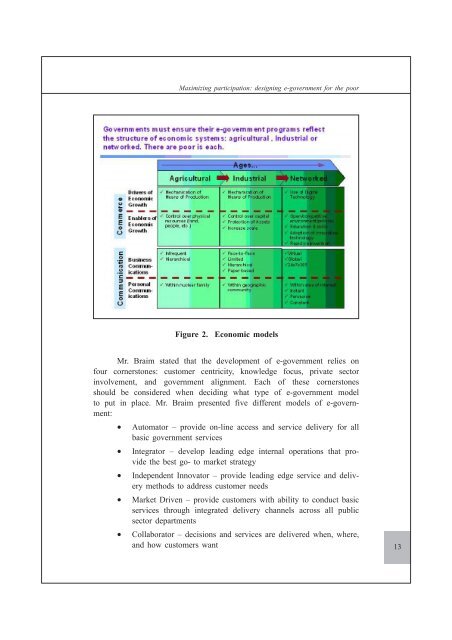- Page 3 and 4: ECONOMIC AND SOCIAL COMMISSION FOR
- Page 5: PREFACE Preface In recent years, th
- Page 8 and 9: vi Contents Contents (Continued) Pa
- Page 10 and 11: viii Abbreviations Abbreviations AB
- Page 12 and 13: x Abbreviations Abbreviations (Cont
- Page 15: PART ONE Summary of the Workshop
- Page 18 and 19: 4 Organization of the Workshop C. O
- Page 20 and 21: 6 Organization of the Workshop 22.
- Page 22 and 23: 8 Enabling local governments to off
- Page 24 and 25: 10 Maximizing participation: design
- Page 28 and 29: 14 Maximizing participation: design
- Page 30 and 31: 16 Stakeholder participation in des
- Page 32 and 33: 18 Stakeholder participation in des
- Page 34 and 35: 20 Developing local e-government po
- Page 36 and 37: 22 Citizen-centric e-government: em
- Page 38 and 39: 24 Citizen-centric e-government: em
- Page 40 and 41: 26 Preparing a project proposal for
- Page 42 and 43: 28 Preparing a project proposal for
- Page 44 and 45: 30 Job training and job placement s
- Page 46 and 47: 32 E-government and the digital div
- Page 48 and 49: 34 Building e-government in Japan g
- Page 50 and 51: 36 Building e-government in Japan T
- Page 52 and 53: 38 Methods of assessing the informa
- Page 54 and 55: 40 Conducive policy environment for
- Page 56 and 57: 42 Conducive policy environment for
- Page 58 and 59: 44 The challenge of implementing e-
- Page 60 and 61: 46 Public key infrastructure initia
- Page 62 and 63: 48 Public key infrastructure initia
- Page 65: PART TWO Summary of Country Reports
- Page 68 and 69: 54 Summary of Country Reports B. Ca
- Page 70 and 71: 56 Summary of Country Reports Howev
- Page 72 and 73: 58 Summary of Country Reports G. Mo
- Page 74 and 75: 60 Summary of Country Reports Likew
- Page 76 and 77:
62 Summary of Country Reports L. Sr
- Page 78 and 79:
64 Summary of Country Reports serva
- Page 81 and 82:
WORKSHOP AGENDA Annex I: Workshop A
- Page 83 and 84:
15:15 - 15:30 Coffee Break 15:30 -
- Page 85 and 86:
Annex I: Workshop Agenda • Farm e
- Page 87:
Annex I: Workshop Agenda • Sell i
- Page 90 and 91:
76 Annex II: List of Participants M
- Page 92 and 93:
78 Annex II: List of Participants R
- Page 94 and 95:
80 Annex II: List of Participants M
- Page 96 and 97:
82 Bangladesh Title: Technical Link
- Page 98 and 99:
84 Bangladesh • An integrated net
- Page 100 and 101:
86 Bangladesh Communication Technol
- Page 102 and 103:
88 Bangladesh Title: Agrobangla-net
- Page 104 and 105:
90 Bangladesh Design Performance Mo
- Page 106 and 107:
92 Bangladesh II. ISSUES • Lack o
- Page 108 and 109:
94 Bangladesh Items Quantity Cost T
- Page 110 and 111:
96 Cambodia Title: Government Admin
- Page 112 and 113:
98 Cambodia The Project Steering Co
- Page 114 and 115:
100 Cambodia Design Performance Mon
- Page 116 and 117:
102 China • Electronic system for
- Page 118 and 119:
104 China Design Performance Monito
- Page 120 and 121:
106 India • All information needs
- Page 122 and 123:
108 India Design Performance Monito
- Page 124 and 125:
110 Indonesia Title: E-on-lending i
- Page 126 and 127:
112 Indonesia Financing plan It is
- Page 128 and 129:
114 Indonesia The online system wil
- Page 130 and 131:
116 Indonesia Title: E-learning in
- Page 132 and 133:
118 Indonesia • 200 scanner - whi
- Page 134 and 135:
120 Indonesia • Miscellaneous adm
- Page 136 and 137:
122 Lao People’s Democratic Repub
- Page 138 and 139:
124 Lao People’s Democratic Repub
- Page 140 and 141:
126 Lao People’s Democratic Repub
- Page 142 and 143:
128 Lao People’s Democratic Repub
- Page 144 and 145:
130 Lao People’s Democratic Repub
- Page 146 and 147:
132 Lao People’s Democratic Repub
- Page 148 and 149:
134 Mongolia Title: Mongolian e-gov
- Page 150 and 151:
136 Mongolia B. Cost estimates and
- Page 152 and 153:
138 Mongolia C. Benefits • Increa
- Page 154 and 155:
140 Myanmar population lives in rur
- Page 156 and 157:
142 Nepal Title: Decentralized mana
- Page 158 and 159:
144 Nepal • Prepare e-government
- Page 160 and 161:
146 Nepal E. Risks The following fa
- Page 162 and 163:
148 Nepal Design Performance Monito
- Page 164 and 165:
150 Nepal • Government services
- Page 166 and 167:
152 Nepal Design Monitoring Assumpt
- Page 168 and 169:
154 Pakistan • Public (i.e. resid
- Page 170 and 171:
156 Pakistan (c) Standard template/
- Page 172 and 173:
158 Philippines Title: Database of
- Page 174 and 175:
160 Philippines Component/item Gran
- Page 176 and 177:
162 Sri Lanka Title: E-land service
- Page 178 and 179:
164 Sri Lanka build the relevant la
- Page 180 and 181:
166 Sri Lanka • Increases capacit
- Page 182 and 183:
168 Sri Lanka Design Performance Mo
- Page 184 and 185:
170 Thailand III. THE PROPOSED PROJ
- Page 186 and 187:
172 Thailand Design Performance Mon
- Page 188 and 189:
174 Thailand Title: Local initiativ
- Page 190 and 191:
176 Thailand C. Implementation arra
- Page 192 and 193:
178 Uzbekistan Title: E-government
- Page 194 and 195:
180 Uzbekistan During implementatio
- Page 196 and 197:
182 Viet Nam Title: E-government in
- Page 198 and 199:
184 Viet Nam C. Implementation arra

















